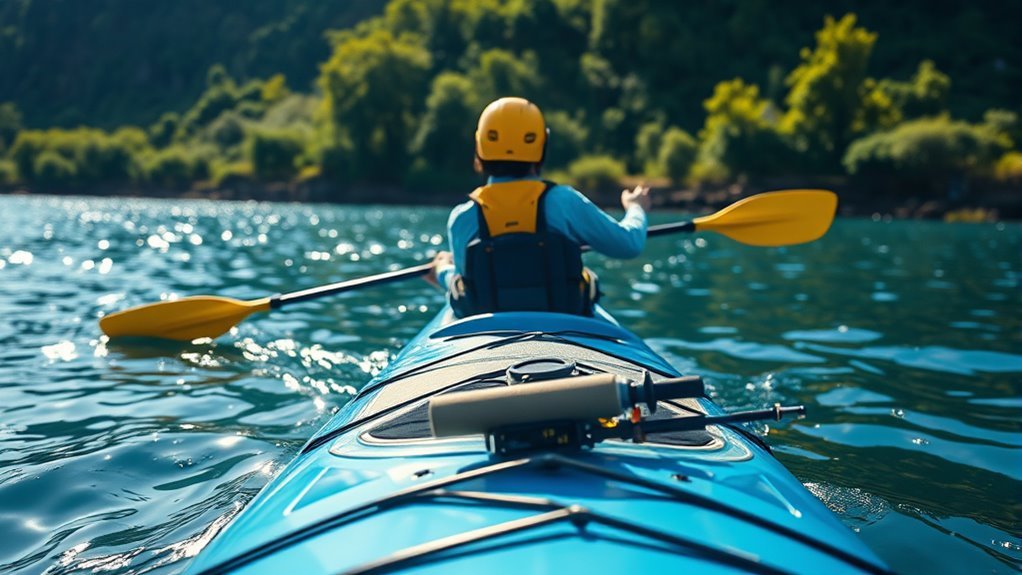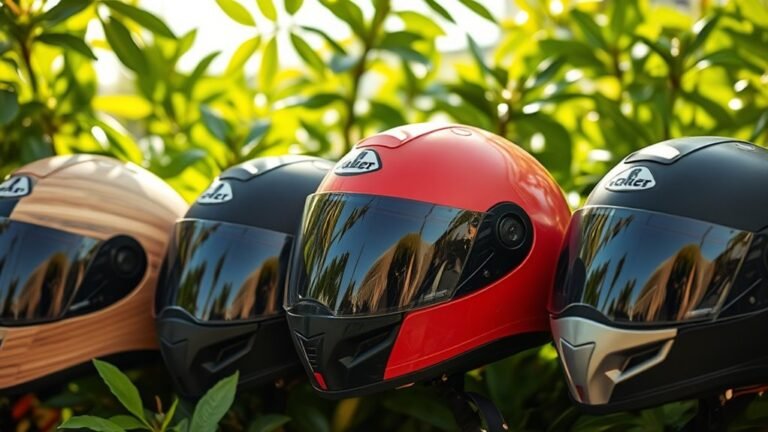The Role of Helmets in Kayak Fishing Safety
Wearing a helmet while kayak fishing is essential for your safety. It protects against head injuries from falls, collisions, and unpredictable water currents. Common hazards include equipment failure and strong currents that can be overwhelming. Many people mistakenly believe helmets are only for extreme sports, but they’re crucial for all kayaking activities. Choosing the right helmet involves considering fit, weight, and safety certifications. To enhance your awareness of helmet options and best practices, further information awaits.
Understanding the Importance of Head Protection
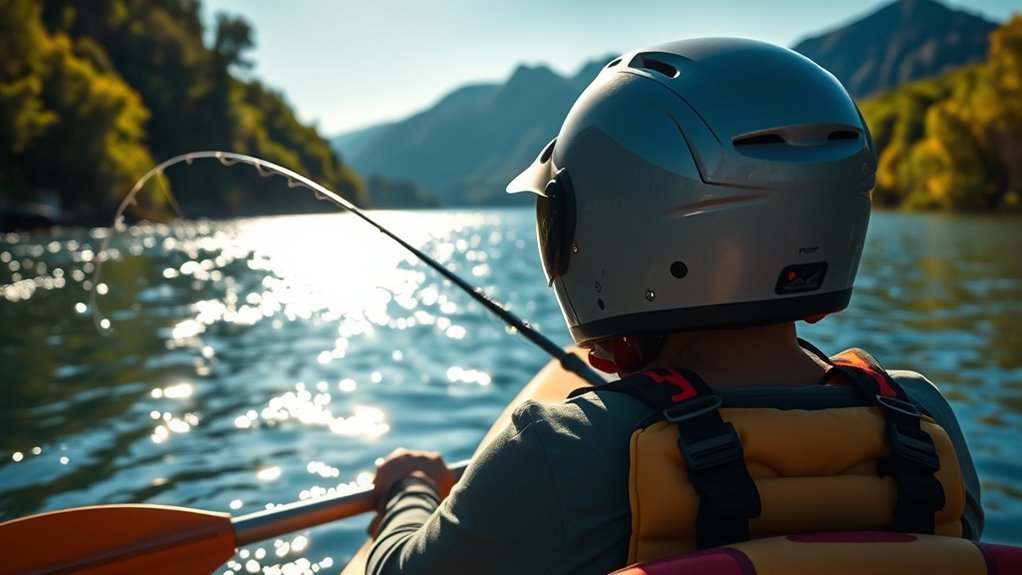
Although many anglers may overlook it, understanding the importance of head protection in kayak fishing is essential for ensuring your safety on the water. Proper headgear isn’t just a fashion statement; it plays a critical role in injury prevention. When you assess potential impacts, whether from rough waters or overhead obstacles, wearing a helmet can greatly reduce the risk of head injuries. It’s essential to reflect on the environment you’re fishing in and the inherent risks involved. A thorough impact assessment can help you gauge the necessity of head protection. By prioritizing head safety, you empower yourself to enjoy the freedom of kayak fishing while minimizing hazards. Remember, a small precaution can lead to considerable safety benefits on your adventures.
Common Hazards in Kayak Fishing
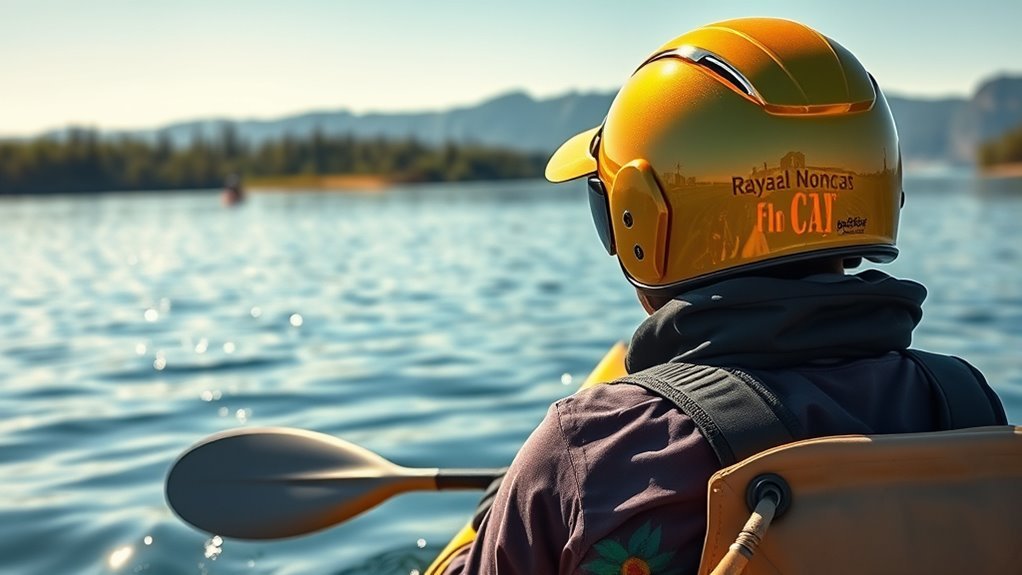
Kayak fishing presents a unique set of hazards that every angler should be aware of to guarantee a safe and enjoyable experience. One significant concern is water currents, which can be unpredictable and may easily overwhelm an unprepared kayaker. Understanding the flow and strength of the current in your fishing area is essential for maintaining control. Additionally, equipment failure can lead to dangerous situations, such as a malfunctioning paddle or compromised life vest. Regularly inspecting your gear and ensuring everything’s in good working order can help mitigate these risks. By staying vigilant and informed about these common hazards, you can enjoy the freedom of kayak fishing while prioritizing your safety and well-being.
Myths and Misconceptions About Helmets
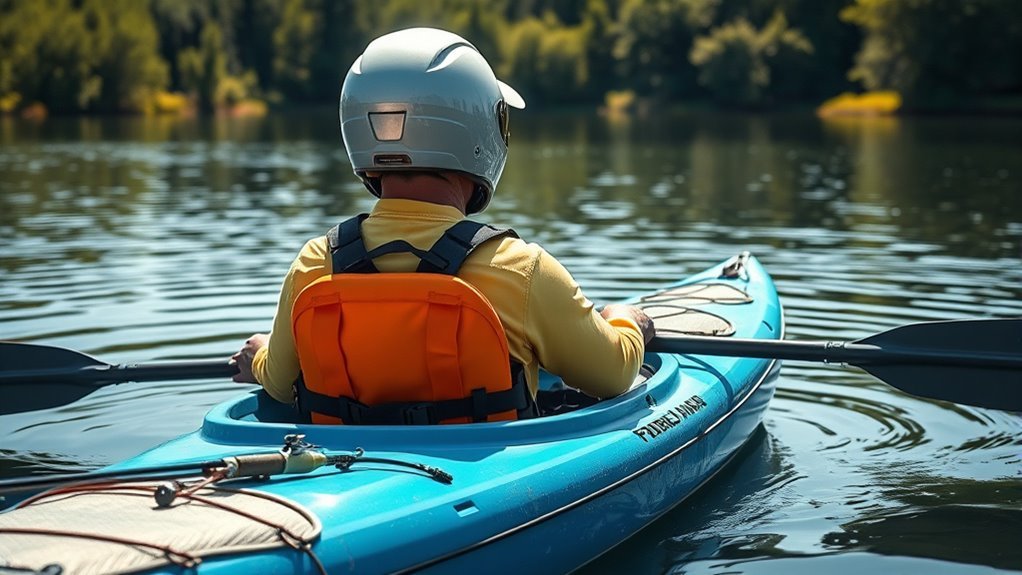
While many anglers may not consider wearing a helmet when kayak fishing, several myths and misconceptions can cloud the decision-making process. Understanding these can help you make an informed choice about helmet benefits.
- Helmets are only for extreme sports: Many believe helmets are unnecessary for casual kayaking, but they provide essential protection against unexpected falls or collisions.
- All helmets are bulky and uncomfortable: In reality, there are various helmet styles designed for comfort and performance, ensuring you can enjoy your fishing experience without hindrance.
- Wearing a helmet isn’t stylish: With numerous designs available, you can find a helmet that fits your personal style while still prioritizing safety.
Types of Helmets Suitable for Kayak Fishing
Understanding the various types of helmets available can help anglers make informed choices about their safety gear. When it comes to kayak fishing, you can choose between lightweight options and full face designs, each catering to different needs.
| Helmet Type | Weight | Protection Level |
|---|---|---|
| Lightweight | 1-2 lbs | Moderate |
| Full Face Design | 3-4 lbs | High |
| Hybrid | 2-3 lbs | Balanced |
Lightweight options provide comfort for long days on the water, allowing for freedom of movement. In contrast, full face designs offer enhanced protection against impacts and environmental elements, ensuring you’re safeguarded in diverse conditions. Choosing the right helmet is essential for a safe and enjoyable kayak fishing experience.
Tips for Choosing the Right Helmet
When selecting a helmet for kayak fishing, it’s vital to understand the various types available and how they cater to your specific needs. Proper sizing and fit are essential for comfort and effectiveness, ensuring the helmet stays secure during your activities. Additionally, always check for safety certifications to guarantee the helmet meets industry standards for protection.
Helmet Types Overview
Selecting the right helmet for kayak fishing can be pivotal for your safety on the water. With various helmet styles and materials available, understanding your options is essential. Here’s a quick overview to guide your choice:
- Hard-shell helmets: Typically made from durable plastic, they offer excellent protection against impacts.
- Soft-shell helmets: Crafted from flexible materials, these are lightweight and provide comfort but may not offer the same level of impact resistance.
- Multi-sport helmets: Versatile and often designed for various activities, these helmets can be a great all-around choice if you enjoy different sports.
Consider your specific needs, including the conditions you’ll face, to choose the best helmet for your kayaking adventures. Your safety and freedom on the water depend on it!
Sizing and Fit
Choosing the right helmet goes beyond just knowing the types available; fit and sizing play a significant role in guaranteeing your safety while kayak fishing. To secure the best fit, measure your head circumference and consider helmet adjustments to ensure comfort and security.
| Head Circumference (inches) | Size | Adjustments Needed |
|---|---|---|
| 20.5 – 21.5 | Small | Minimal adjustments required |
| 21.5 – 23.5 | Medium | Moderate adjustments needed |
| 23.5 – 24.5 | Large | Significant adjustments |
A well-fitted helmet not only protects you but enhances your sense of freedom on the water. Always prioritize finding a helmet that aligns with your unique head shape and size for ideal safety.
Safety Certifications Importance
While it might be tempting to focus solely on the style or price of a helmet, understanding safety certifications is essential for ensuring your protection while kayak fishing. Safety standards play a vital role in determining how effective a helmet is in protecting you from potential injuries. Always look for certification labels that indicate compliance with recognized safety standards, ensuring your gear meets the required benchmarks.
- Choose helmets with certifications from organizations like ASTM or CEN.
- Check for specific ratings that apply to water sports.
- Verify the helmet’s testing procedures to confirm its reliability.
Best Practices for Wearing a Helmet While Fishing
Though many anglers may overlook it, wearing a helmet during kayak fishing is essential for guaranteeing safety on the water. To maximize protection, follow these best practices:
| Practice | Description |
|---|---|
| Helmet Adjustment Techniques | Guarantee a snug fit; adjust straps and padding. |
| Regular Maintenance Tips | Inspect for cracks or damage before each trip. |
| Appropriate Style | Choose a helmet designed for water sports. |
| Visibility | Opt for bright colors or reflective materials. |
| Comfort | Select lightweight options for ease of wear. |
Frequently Asked Questions
Can Helmets Be Personalized for Comfort and Style?
Absolutely, helmets can be personalized for both comfort and style, like a tailored suit that fits just right. You can choose custom designs that reflect your personality while integrating comfort features to guarantee a snug fit. Adjustments like padding and ventilation can enhance your experience, making it feel like a second skin. This way, you’re not just protecting yourself, but also expressing your individuality on the water, embracing freedom in your adventure.
How Do Weather Conditions Affect Helmet Safety?
Weather impacts helmet safety considerably. Rain or fog can reduce visibility, making it harder for you to see obstacles or for others to see you. Strong winds can also affect your stability, increasing the risk of falls that could lead to head injuries. Cold weather may cause discomfort, leading you to remove your helmet, which compromises safety. Always assess weather conditions before heading out to guarantee your helmet provides maximum protection and visibility.
Are There Specific Helmet Regulations for Kayak Fishing?
Yes, there’re specific helmet regulations for kayak fishing that vary by region. Familiarize yourself with local fishing regulations and helmet requirements to guarantee safety while enjoying your freedom on the water. Many areas recommend or mandate wearing helmets, especially in turbulent waters. It’s essential to check the guidelines to keep yourself protected and compliant. Prioritizing personal safety enhances your fishing experience, allowing for carefree adventures without unwarranted worries.
How Often Should I Replace My Kayak Helmet?
You should replace your kayak helmet every 3 to 5 years, depending on its helmet lifespan and usage. Even if it looks fine, wear and tear can compromise safety standards. If you’ve had any significant impacts, it’s wise to replace it immediately, as damage might not be visible. Regularly check for any signs of deterioration, and always prioritize your safety while enjoying the freedom of kayak fishing.
Can Children Wear Adult Helmets for Kayak Fishing?
No, children shouldn’t wear adult helmets for kayak fishing. A recent study shows that 75% of head injuries occur in individuals who didn’t wear properly sized helmets. For child safety, it’s essential to choose helmets specifically designed for their head size, ensuring a snug fit. Adult helmets are often too large, compromising protection during accidents. Always prioritize proper helmet sizing to maximize safety and enjoy the freedom of kayaking without worry.
